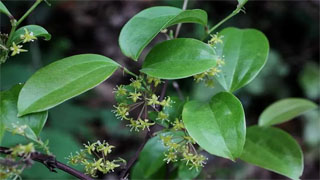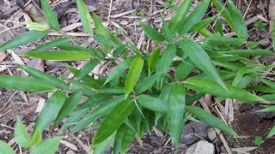
1. Alias
Diamond Head, Golden Ganggen, False Bixie, Diamond Thorn, Cold Rice Bar.
2. Plant morphology
Fallen leaves climb shrubs. The rhizome runs horizontally, irregularly curved, thick and hard, with sparse fibrous roots. The stem is slender, with inverted or flat sparse spines. Leaves alternate, broadly ovate, round or ovate elliptical in shape, apex pointed or rounded, base heart-shaped, shallowly heart-shaped or broadly wedge-shaped, entire margin, 3-5 veins; The leaf sheath accounts for 2/3 of the petiole, with 2 tendrils on both sides along the lower part of the petiole. After the leaf falls off, a section of the petiole remains. Umbelliferae inflorescence axillary; Bracts ovate lanceolate; Flowers are unisexual, dioecious, with 6 or 2 whorls of perianth, rectangular in shape, and yellow green in color; Male flowers have 3 outer whorl petals, elongated elliptical in shape, and 3 inner whorl petals, ovate lanceolate in shape; Female flowers have 3-6 degenerated stamens, an upper ovary, long ovate shape, 3 chambers, and a 3-lobed stigma. Berry spherical, red when ripe, with powdery frost. The flowering period is from April to May, and the fruiting period is from May to July.
3. Origin distribution
Born in forests, shrubs, or slopes below an altitude of 2000 meters. Distributed in Jiangsu, Fujian, Hunan, Sichuan and other places.
4. Harvesting and processing
Excavate from late autumn to spring of the following year, remove roots and sediment, wash, slice or block, and dry in the sun.
5. Characteristics of medicinal herbs
Curved flattened cylindrical or irregular block shaped, with raised nodules, 10-20 centimeters long and 2-4 centimeters in diameter. The surface is yellow brown or purple brown, and there are hard fibrous root residues and bud marks at the swollen nodules, or hard curved fine roots. Hard in texture, difficult to break, with a yellow brown to reddish brown cross-section, flat, fibrous. The air is faint and the taste is slightly bitter.
6. Sexual Taste Returning to the Classics
Flat in nature, sweet and sour in taste. Return to the liver meridian and kidney meridian.
7. Effect and Function
Dispelling wind and dampness, promoting urination, reducing swelling and toxins. Diuretic and gonococcal drugs classified under the category of diuretics and diuretics.
8. Clinical application
Take 9-15 grams and decoct; Or soaking in alcohol; Or into pills or powder. Used to treat joint pain, muscle numbness, diarrhea, dysentery, edema, and gonorrhea. Apply an appropriate amount topically, boil and wash with water, and use to treat sores, swelling, scrofula, and hemorrhoids.
9. Pharmacological research
Has antibacterial, anti-inflammatory, anti-tumor and other effects. Animal experiments have shown that its decoction has diuretic, detoxifying, and anti trypanosomal effects, and has inhibitory effects on Staphylococcus aureus, Pseudomonas aeruginosa, and Escherichia coli in vitro.
10. Chemical composition
Containing sarsapogenin A, sarsapogenin B, and sarsapogenin C, with sarsapogenin B having the highest content. Hydrolyzed to obtain diosgenin, three molecules of glucose, and three molecules of rhamnose. In addition, it contains ingredients such as octacosal, polyols, naringenin, sarsaparicin, isohesperidin, kaempferol, kaempferol, dioscin, and isohesperidin.
11. Usage taboos
Harmful to individuals with a hot temperament, appropriate medication may be prescribed as appropriate. Avoid vinegar and tea.
12. Compatibility prescription
① Treatment for gonorrhea: 15 grams of sarsaparilla root (stir fried in salt water), 9 grams of honeysuckle, and 6 grams of flat storage. Boil it in water. (Hunan Pharmaceutical Journal)
② Treating blood mercury: 30 grams each of Smilax root and Suanzhang root. Fry and serve. (Anhui Chinese Herbal Medicine)
③ Treatment of diabetes: 60~120g fresh sarsaparilla root, stewed with a pig pancreas, 1 dose per day. (New Compilation of Materia Medica in Southern Zhejiang)
④ Treatment of collapse and leakage: 30 grams each of Smilax root and palm charcoal. Fry and serve. (Anhui Chinese Herbal Medicine)
⑤ Treating vomiting blood: Take 6g of Smilax root and 9g of ground tea, decoct in water and take orally. (Hunan Pharmaceutical Journal)
⊙ The content of the article is for clinical reference only. Non TCM professionals are not allowed to test drugs.


